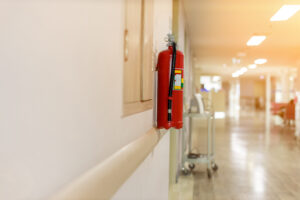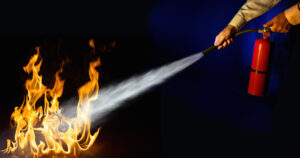
How Portable Fire Extinguishers Can Reduce a Building’s Carbon Footprint
One recent study found that the usage of both sprinklers and portable fire extinguishers can reduce the carbon footprint of a structure fire by 99 percent.
One often-overlooked source of carbon emissions is building fires. This means that the little red fire extinguisher in the corner of your office building, apartment complex or home could be a significant weapon in the battle against climate change.
Fire risk accounts for one to two percent of a building’s overall carbon footprint. Structure fires are estimated to contribute between 0.5 to one percent of the country’s total carbon footprint, amounting to a staggering 25 to 50 million metric tons of carbon dioxide (CO2) emissions annually.
This is equivalent to more than the output of five to 10 million cars per year, and these numbers don’t consider automobile fires, trash fires or wildfires.
As governments work towards a united and comprehensive approach to tackling climate change, it is important to account for the entire carbon footprint of a building, especially when one major source of emissions — building fires — can easily and effectively be managed.
Practicing Safe and Effective Fire Prevention Reduces Carbon Emissions
The federal government has pledged to reduce carbon emissions by 50 percent by 2032 and to achieve net-zero building emissions by 2045. Taking action to prevent structure fires is one of the most effective means to avoid the release of CO2.
Once a fire starts, the earlier it is extinguished, the lower the amount of CO2 is released. So, when a fire is small — in its incipient stage — it is the best time to address the issue. And that means arming ourselves with the necessary tool: a portable fire extinguisher.

In fact, one recent study found that the usage of both sprinklers and portable fire extinguishers can reduce the carbon footprint of a structure fire by 99 percent.
This swift intervention prevents the fire from spreading and often results in complete extinguishment prior to firefighters arriving on the scene.
Relying solely on automatic fire suppression equipment can lead to collateral damage to furnishings because sprinkler systems are not able to distinguish between a minor fire and a full-scale inferno. Individuals, however, can easily use fire extinguishers and effectively prevent fires from spreading while minimizing the potential damage caused by automatic fire suppression systems.
Combatting Climate Change with Layered Fire Protection
Fire safety experts have long emphasized the importance of layered fire protection by having readily accessible fire extinguishers in buildings. These devices empower individuals to take immediate action when a fire breaks out, allowing them to contain or even extinguish flames before they escalate.
A study by Worcester Polytechnic Institute and Eastern Kentucky University found that 98 percent of participants were able to successfully use an extinguisher by pulling the pin, squeezing the trigger and discharging the extinguisher, with nearly 74 percent using the proper technique of aiming at the base of the fire and using a back-and-forth motion until the fire is extinguished.

With just a few minutes of training, those percentages went up to 100 percent and 96 percent, respectively.2 By equipping people with the knowledge and tools to combat fires, we can significantly reduce the potential for property damage, injuries and loss of life — while also reducing carbon emissions.
Furthermore, embracing the installation and use of portable fire extinguishers aligns with a broader ethos of individual responsibility and preparedness. Just as we equip ourselves with seat belts and airbags in vehicles or install smoke detectors and carbon monoxide alarms in our homes, having fire extinguishers readily available is a prudent step toward safeguarding our well-being. It empowers individuals to take an active role in fire prevention and response, fostering a sense of community resilience and bolstering safety.
As we strive to combat climate change and reduce carbon emissions, every avenue for reduction should be explored. Addressing fire safety in buildings should not be viewed in isolation but, rather, as part of a comprehensive strategy to prevent climate change.
By providing individuals with the means to combat small fires, we can prevent them from growing into catastrophic events, reducing both the immediate danger and the subsequent release of carbon emissions.
This article was written in partnership with the Fire Equipment Manufacturers’ Association (FEMA). FEMA is an international, non-profit trade association dedicated to manufacturing commercial fire protection equipment to serve as the first line of defense against fire in its early stages. The Code Council’s Sustainability Membership Council applauds the initiative of this report and supports fire extinguisher installation to decrease global carbon emissions.







